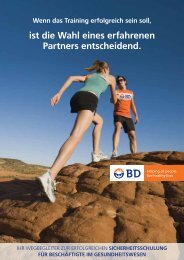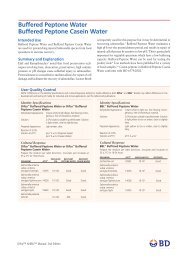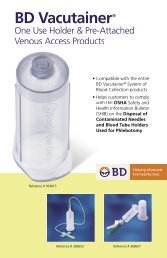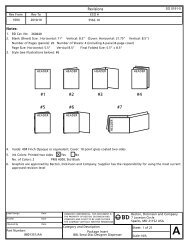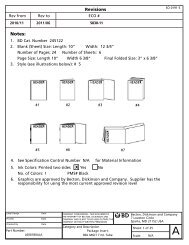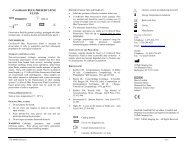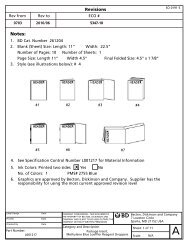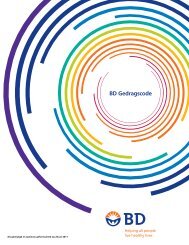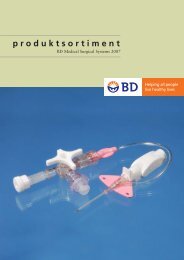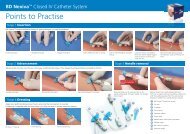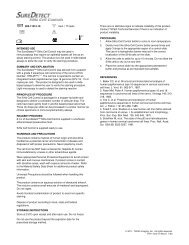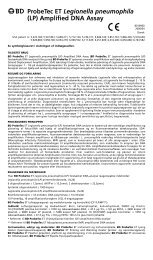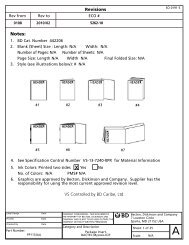BBL Group A Selective Strep Agar with 5% Sheep Blood (ssA ) - BD
BBL Group A Selective Strep Agar with 5% Sheep Blood (ssA ) - BD
BBL Group A Selective Strep Agar with 5% Sheep Blood (ssA ) - BD
Create successful ePaper yourself
Turn your PDF publications into a flip-book with our unique Google optimized e-Paper software.
!<br />
<strong>BBL</strong> <strong>Group</strong> A <strong>Selective</strong> <strong>Strep</strong> <strong>Agar</strong><br />
<strong>with</strong> <strong>5%</strong> <strong>Sheep</strong> <strong>Blood</strong> (<strong>ssA</strong>)<br />
L007378 • Rev. 07 • May 2006<br />
QUALITY CONTROL PROCEDURES<br />
I INTRODUCTION<br />
<strong>Group</strong> A <strong>Selective</strong> <strong>Strep</strong> <strong>Agar</strong> <strong>with</strong> <strong>5%</strong> <strong>Sheep</strong> <strong>Blood</strong> (<strong>ssA</strong>) is a selective medium for use in the isolation and presumptive identification<br />
of group A streptococci from throat cultures and other specimens.<br />
II PERFORMANCE TEST PROCEDURE<br />
1. Inoculate representative samples <strong>with</strong> the cultures diluted to contain 103 –104 CFU/0.01 mL.<br />
a. To each plate or sector, add 0.01 mL of the dilution and streak for isolation. Stab the agar in the primary streak area<br />
before streaking the rest of the plate.<br />
b. Place a Taxo A disc at the intersection of the first and second areas of streaking on all plates inoculated <strong>with</strong><br />
S. pyogenes strains.<br />
c. Incubate plates at 35 ± 2°C in an aerobic atmosphere supplemented <strong>with</strong> 3–7% carbon dioxide.<br />
d. Include Trypticase Soy <strong>Agar</strong> <strong>with</strong> <strong>5%</strong> <strong>Sheep</strong> <strong>Blood</strong> <strong>Agar</strong> (TSA II) plates as nonselective controls for all organisms.<br />
2. Examine plates after 18–24 h for beta hemolysis in the stabbed area and for amount of growth, inhibition, colony size and<br />
hemolytic reactions. Read and record the size of the zone around the Taxo A disc <strong>with</strong> S. pyogenes.<br />
3. Expected Results<br />
Organisms ATCC Recovery<br />
*<strong>Strep</strong>tococcus pyogenes 19615 For both strains, fair to heavy growth (depending on the<br />
<strong>Strep</strong>tococcus pyogenes 51574 strain and dilution) of pinpoint to very small colonies<br />
surrounded by zones of beta hemolysis. A zone of growth<br />
inhibition is clearly evident around the Taxo A disc.<br />
<strong>Strep</strong>tococcus mitis 6249 Partial inhibition<br />
*Staphylococcus aureus 25923 Complete inhibition<br />
Neisseria subflava 14799 Complete inhibition<br />
Pseudomonas aeruginosa 27853 Complete inhibition<br />
*Recommended organism strain for User Quality Control.<br />
III ADDITIONAL QUALITY CONTROL<br />
1. Examine plates as described under “Product Deterioration.”<br />
2. Visually examine representative plates to assure that any existing physical defects will not interfere <strong>with</strong> use.<br />
3. Determine the pH potentiometrically at room temperature for adherence to the specification of 7.4 ± 0.2.<br />
4. Note the firmness of plates during the inoculation procedure.<br />
5. Incubate uninoculated representative plates at 35 ± 2°C in an aerobic atmosphere supplemented <strong>with</strong> 3–7% CO 2 for 72 h<br />
and examine for microbial contamination.<br />
PRODUCT INFORMATION<br />
IV INTENDED USE<br />
<strong>Group</strong> A <strong>Selective</strong> <strong>Strep</strong> <strong>Agar</strong> <strong>with</strong> <strong>5%</strong> <strong>Sheep</strong> <strong>Blood</strong> (<strong>ssA</strong>) is recommended as a primary selective plating medium for the<br />
isolation of group A streptococci (S. pyogenes) from throat cultures and other specimens in which the presence of S. pyogenes<br />
is suspected. <strong>Group</strong> B streptococci will also grow on this medium; most other streptococci, neisseriae, staphylococci and gramnegative<br />
bacteria are inhibited. The medium is designed for use in conjunction <strong>with</strong> Taxo A (bacitracin, 0.04 unit) discs for<br />
presumptive identification of S. pyogenes.<br />
V SUMMARY AND EXPLANATION<br />
Infection <strong>with</strong> Lancefield group A streptococci (S. pyogenes) may produce serious sequelae such as rheumatic fever and acute<br />
glomerulonephritis. Therefore, early detection and identification are important.<br />
Because of the overgrowth of normal flora present in throat culture specimens inoculated onto routine blood agar plates,<br />
selective ingredients have been added to sheep blood agar to enhance the detection of group A streptococci.<br />
Evaluation of various antimicrobial agents in our laboratories resulted in a combination <strong>with</strong> improved selectivity over other<br />
selective media tested. This medium (<strong>ssA</strong>) allows presumptive identification of group A streptococci, based on bacitracin<br />
susceptibility and beta hemolysis, <strong>with</strong>in 24 h after inoculation <strong>with</strong> the specimen when the medium is incubated in a CO2- enriched atmosphere. 1<br />
The JEMBEC system offers a convenient CO2 atmosphere for an individual plate. It consists of the selective culture medium<br />
(<strong>ssA</strong>) in a rectangular plate <strong>with</strong> a special well to hold a CO2-generating tablet. A resealable plastic bag is provided to maintain<br />
the CO2-enriched environment during incubation. The system may be inoculated and incubated at the site of specimen<br />
collection or used for specimen transport and growth of S. pyogenes. It has the advantage over other transport systems of<br />
obviating the necessity of transferring the specimen from the transport system to a culture plate.<br />
VI PRINCIPLES OF THE PROCEDURE<br />
The base medium, modified Trypticase Soy <strong>Agar</strong> (TSA II), provides a combination of casein and soy peptones that supply<br />
organic nitrogen. The sodium chloride maintains osmotic equilibrium. Defibrinated sheep blood provides proper hemolytic<br />
reactions of streptococci. In addition, growth of Haemophilus hemolyticus, a nonpathogen whose hemolytic colonies are<br />
indistinguishable from those of beta-hemolytic streptococci, is inhibited. The incorporation of a unique combination of<br />
selective ingredients provides improved suppression of normal throat flora for improved recovery of S. pyogenes.<br />
L007378 1 of 3
Beta-hemolytic streptococci which show a zone of inhibition around a bacitracin (0.04 unit) disc may be presumptively<br />
identified as group A streptococci.<br />
In the JEMBEC system, a CO2-generating tablet is placed in a well <strong>with</strong>in the plate and is activated by the moisture produced by<br />
the culture medium <strong>with</strong>in the sealed plastic bag. The CO2 level generated is sufficient for the growth of S. pyogenes on the<br />
selective medium provided <strong>with</strong> the system.<br />
VII REAGENTS<br />
<strong>Group</strong> A <strong>Selective</strong> <strong>Strep</strong> <strong>Agar</strong> <strong>with</strong> <strong>5%</strong> <strong>Sheep</strong> <strong>Blood</strong> (<strong>ssA</strong>)<br />
Approximate Formula* Per Liter Purified Water<br />
Pancreatic Digest of Casein..................................................14.5 g<br />
Papaic Digest of Soybean Meal ............................................5.0 g<br />
Sodium Chloride ....................................................................5.0 g<br />
<strong>Agar</strong> ......................................................................................14.0 g<br />
Growth Factors ......................................................................1.5 g<br />
<strong>Selective</strong> Agents....................................................................40.2 mg<br />
<strong>Sheep</strong> <strong>Blood</strong>, defibrinated ....................................................<strong>5%</strong><br />
*Adjusted and/or supplemented as required to meet performance criteria.<br />
JEMBEC System<br />
In addition to the plated medium, the JEMBEC System consists of resealable polyethylene bags and CO2-generating tablets<br />
(sodium bicarbonate and citric acid).<br />
Warnings and Precautions: For in vitro Diagnostic Use.<br />
If excessive moisture is observed, invert the bottom over an off-set lid and allow to air dry in order to prevent formation of a<br />
seal between the top and bottom of the plate during incubation.<br />
Pathogenic microorganisms, including hepatitis viruses and Human Immunodeficiency Virus, may be present in clinical<br />
specimens. "Standard Precautions" 2-5 and institutional guidelines should be followed in handling all items contaminated <strong>with</strong><br />
blood and other body fluids. After use, prepared plates, specimen containers and other contaminated materials must be<br />
sterilized by autoclaving before discarding.<br />
Storage Instructions: On receipt, store plates in the dark at 2–8°C. Avoid freezing and overheating. Do not open until ready to<br />
use. Minimize exposure to light. Prepared plates stored in their original sleeve wrapping at 2–8°C until just prior to use may be<br />
inoculated up to the expiration date and incubated for recommended incubation times. Allow the medium to warm to room<br />
temperature before inoculation.<br />
Product Deterioration: Do not use plates if they show evidence of microbial contamination, discoloration, drying, cracking or<br />
other signs of deterioration.<br />
VIII SPECIMEN COLLECTION AND HANDLING<br />
Throat specimens suitable for culture may be obtained by swabbing the pharynx and tonsillar area of the throat <strong>with</strong> a<br />
polyester- or polyurethane-tipped swab, taking care to avoid touching the tongue or uvula. (Note: if swabs are also used <strong>with</strong><br />
direct antigen detection tests, the use of polyester, rayon or polyurethane swabs on plastic shafts is required; e.g.,<br />
CultureSwab Collection and Transport Systems. Sources other than the throat should be cultured according to recommended<br />
procedures. For detailed information, appropriate texts should be consulted. 6,7 Specimens should be obtained before<br />
antimicrobial therapy has been administered. Provision must be made for prompt delivery to the laboratory.<br />
IX PROCEDURE<br />
Material Provided: <strong>Group</strong> A <strong>Selective</strong> <strong>Strep</strong> <strong>Agar</strong> <strong>with</strong> <strong>5%</strong> <strong>Sheep</strong> <strong>Blood</strong> (<strong>ssA</strong>)<br />
Materials Required But Not Provided: Ancillary culture media, reagents, quality control organisms and laboratory equipment as<br />
required.<br />
Test Procedure: Observe aseptic techniques.<br />
The agar surface should be smooth and moist, but <strong>with</strong>out excessive moisture.<br />
As soon as possible, inoculate the specimen onto a <strong>Group</strong> A <strong>Selective</strong> <strong>Strep</strong> <strong>Agar</strong> <strong>with</strong> <strong>5%</strong> <strong>Sheep</strong> <strong>Blood</strong> (<strong>ssA</strong>) plate by firmly<br />
rolling the swab over a third of the agar surface. Streak the remainder of the plate <strong>with</strong> a sterilized or sterile disposable<br />
inoculating loop to obtain isolated colonies. After streaking, stab the agar two or three times in the area of heaviest<br />
inoculation.<br />
Place a Taxo A disc directly on the swabbed portion of the plate; i.e., where the swabbed area is intersected by the area of<br />
initial loop streaking. It is recommended that a routine blood agar plate, such as a Trypticase Soy <strong>Agar</strong> <strong>with</strong> <strong>5%</strong> <strong>Sheep</strong> <strong>Blood</strong><br />
plate (TSA II) also be inoculated to assure the recovery of microorganisms that may be inhibited on the selective medium.<br />
Incubate inoculated plates at 35 ± 2°C in an atmosphere enriched <strong>with</strong> 3–7% carbon dioxide. If plates are incubated <strong>with</strong>out<br />
carbon dioxide, the beta-hemolytic zones and colony size will be smaller and fewer colonies may be apparent.<br />
Examine plates after 18–24 h.<br />
For the JEMBEC system:<br />
1. Hold the plate firmly in either hand <strong>with</strong> the tablet-well turned toward you.<br />
2. Lift the lid so that the plate may be held open <strong>with</strong> one hand.<br />
3. Beginning at one end of the rectangular plate, inoculate one-third the length of the medium surface. Spread the inoculum<br />
over the remainder of the medium surface <strong>with</strong> a sterilized or sterile disposable loop to obtain isolated colonies.<br />
4. Place a Taxo A disc as described above.<br />
To generate CO2 :<br />
1. Open foil package and remove the tablet <strong>with</strong> forceps.<br />
2. Place the tablet into the well.<br />
3. Close the lid.<br />
L007378 2 of 3
4. Place the plate in the bag provided and seal securely. It is not necessary to moisten or add water to the CO2-generating tablet; the moisture is supplied by the medium during incubation.<br />
Incubate for 18–24 h at 35 ± 2°C.<br />
User Quality Control: See “Quality Control Procedures.”<br />
Quality Control requirements must be performed in accordance <strong>with</strong> applicable local, state and/or federal regulations or<br />
accreditation requirements and your laboratory’s standard Quality Control procedures. It is recommended that the user refer to<br />
pertinent CLSI (formerly NCCLS) guidance and CLIA regulations for appropriate Quality Control practices.<br />
X RESULTS<br />
After 18–24 h of incubation in an atmosphere enriched <strong>with</strong> carbon dioxide, group A streptococci (S. pyogenes) will appear as<br />
translucent or opaque, white to gray, small (1 to 2 mm) colonies surrounded by a zone of beta hemolysis. A decrease in size as<br />
compared to a nonselective control is typical. Pinpoint or very small colonies of alpha-, nonhemolytic or other beta-hemolytic<br />
streptococci may grow in small numbers, but they should not interfere <strong>with</strong> the recovery of group A streptococci or<br />
interpretation of the results. Neisseria species, viridans streptococci, staphylococci, gram-negative rods and most beta-hemolytic<br />
streptococci other than groups A and B are inhibited. Bacitracin susceptibility may be used to differentiate group A streptococci<br />
from group B. Fair to heavy growth of beta-hemolytic colonies demonstrating a zone of inhibition around the Taxo A disc on<br />
this medium may be presumptively reported as S. pyogenes. A PYR (pyroglutamic acid) test may also be performed. It is more<br />
specific and as sensitive as the bacitracin test for this purpose. 8 Gram stains should be made and examined.<br />
A serological grouping test procedure may be performed if sufficient well-isolated beta-hemolytic colonies are present.<br />
XI LIMITATIONS OF THE PROCEDURE<br />
Since there is no such entity as a perfect medium, some strains of group A streptococci (S. pyogenes) may be encountered that<br />
will grow poorly on this medium; the nature of the specimens and the physiologic state of the organisms can influence<br />
recovery of the desired species, as well as modify the effects of the inhibitory characteristics of this medium. It is therefore<br />
useful to examine nonselective controls and compare them to the selective medium to obtain additional information and to<br />
assure optimal recovery of any potential pathogens.<br />
This prepared plated medium is intended for primary isolation. Some diagnostic tests may be performed <strong>with</strong> the primary<br />
plate. However, a pure culture is recommended for biochemical tests and serological procedures. Consult appropriate texts for<br />
detailed information and recommended procedures. 6,7,9-12<br />
XII PERFORMANCE CHARACTERISTICS<br />
In a clinical evaluation consisting of 460 throat cultures, there was a total of 117 positive for group A streptococci on the <strong>Group</strong><br />
A <strong>Selective</strong> <strong>Strep</strong> <strong>Agar</strong> <strong>with</strong> <strong>5%</strong> <strong>Sheep</strong> <strong>Blood</strong> (<strong>ssA</strong>) compared to 100 on SXT <strong>Sheep</strong> <strong>Blood</strong> <strong>Agar</strong> and 84 on Trypticase Soy <strong>Agar</strong><br />
<strong>with</strong> <strong>5%</strong> <strong>Sheep</strong> <strong>Blood</strong> (TSA II). Of these positive cultures, 103 were identified based on beta hemolysis and bacitracin (0.04 unit)<br />
susceptibility <strong>with</strong>in 24 h <strong>with</strong> <strong>ssA</strong> compared <strong>with</strong> 80 on SXT and only 32 on the nonselective TSA blood agar control.13<br />
XIII AVAILABILITY<br />
Cat. No. Description<br />
221779 <strong>BBL</strong> <strong>Group</strong> A <strong>Selective</strong> <strong>Strep</strong> <strong>Agar</strong> <strong>with</strong> <strong>5%</strong> <strong>Sheep</strong> <strong>Blood</strong> (<strong>ssA</strong>), Pkg. of 20 plates<br />
221780 <strong>BBL</strong> <strong>Group</strong> A <strong>Selective</strong> <strong>Strep</strong> <strong>Agar</strong> <strong>with</strong> <strong>5%</strong> <strong>Sheep</strong> <strong>Blood</strong> (<strong>ssA</strong>), Ctn. of 100 plates<br />
221936 <strong>BBL</strong> <strong>Group</strong> A <strong>Selective</strong> <strong>Strep</strong> <strong>Agar</strong> <strong>with</strong> <strong>5%</strong> <strong>Sheep</strong> <strong>Blood</strong> (<strong>ssA</strong>), Pkg. of 20 JEMBEC plates<br />
XIV REFERENCES<br />
1. Evans, G.L., and T.E. O‘Neill. 1984. Development of an improved selective medium for the isolation of group A streptococci from throat<br />
cultures, abstr. C-136, p. 259. Abstr. 84th Annu. Meet. Am. Soc. Microbiol. 1984.<br />
2. National Committee for Clinical Laboratory Standards. 2001. Approved Guideline M29-A2. Protection of laboratory workers from<br />
occupationally acquired infections, 2nd ed. NCCLS, Wayne, PA.<br />
3. Garner, J.S. 1996. Hospital Infection Control Practices Advisory Committee, U.S. Department of Health and Human Services, Centers for<br />
Disease Control and Prevention. Guideline for isolation precautions in hospitals. Infect. Control Hospital Epidemiol. 17:53-80.<br />
4. U.S. Department of Health and Human Services. 1999. Biosafety in microbiological and biomedical laboratories, HHS Publication (CDC), 4th<br />
ed. U.S. Government Printing Office, Washington, D.C.<br />
5. Directive 2000/54/EC of the European Parliament and of the Council of 18 September 2000 on the protection of workers from risks related to<br />
exposure to biological agents at work (seventh individual directive <strong>with</strong>in the meaning of Article 16(1) of Directive 89/391/EEC). Official<br />
Journal L262, 17/10/2000, p. 0021-0045.<br />
6. Murray, P.R., E.J. Baron, J.H. Jorgensen, M.A. Pfaller, and R. H. Yolken (ed.). 2003. Manual of clinical microbiology, 8th ed. American Society<br />
for Microbiology, Washington, D.C.<br />
7. Forbes, B.A., D.F. Sahm, and A.S. Weissfeld. 2002. Bailey and Scott's diagnostic microbiology, 11th ed. Mosby, Inc., St. Louis.<br />
8. Ruoff, K.L., R.A. Whiley, and D. Beighton. 1999. <strong>Strep</strong>tococcus, p. 283-296. In P.R. Murray, E.J. Baron, M.A. Pfaller, F.C. Tenover, and R.H. Yolken<br />
(ed.), Manual of clinical microbiology, 7th ed. American Society for Microbiology, Washington, D.C.<br />
9. Holt, J.G., N.R. Krieg, P.H.A. Sneath, J.T. Staley, and S.T. Williams (ed.). 1994. Bergey's Manual of determinative bacteriology, 9th ed.<br />
Williams & Wilkins, Baltimore.<br />
10. MacFaddin, J.F. 2000. Biochemical tests for identification of medical bacteria, 3rd ed. Lippincott Williams & Wilkins, Baltimore.<br />
11. Koneman, E.W., S.D. Allen, W.M. Janda, P.C. Schreckenberger, and W.C. Winn, Jr. 1997. Color atlas and textbook of diagnostic microbiology,<br />
5th ed. Lippincott-Raven, Philadelphia.<br />
12. Isenberg, H.D. (ed.). 2004. Clinical microbiology procedures handbook, vol. 1, 2 and 3, 2nd ed. American Society for Microbiology,<br />
Washington, D.C.<br />
13. Carlson, J.R., W.G. Merz, B.E. Hansen, S. Ruth, and D.G. Moore. 1985. Improved recovery of group A beta-hemolytic streptococci <strong>with</strong> a new<br />
selective medium. J. Clin. Microbiol. 21:307-309.<br />
Becton, Dickinson and Company<br />
7 Loveton Circle<br />
Sparks, Maryland 21152 USA<br />
800-638-8663<br />
ATCC is a trademark of the American Type Culture Collection.<br />
JEMBEC is a trademark of Miles Scientific.<br />
<strong>BD</strong>, <strong>BD</strong> Logo, <strong>BBL</strong>, CultureSwab, <strong>ssA</strong>, Taxo and Trypticase are trademarks of Becton, Dickinson and Company. ©2006 <strong>BD</strong>.<br />
L007378 3 of 3



